|
Advantech ARK-3403 Box PC
Intel Atom-based rugged and highly configurable fanless industrial PC with PCI/PCIe expansion for a variety of embedded controller applications
(by Conrad H. Blickenstorfer; photography by Carol Cotton)
This article is about the Advantech ARK-3403, a compact, economical Box IPC. What is a "Box IPC"? Well, "box" is "box" and refers to the device's boxlike design. And IPC stands for "Industrial PC." So the ARK-3403—like hundreds of thousands or perhaps millions like it from vendors specializing on just this type of computer—represents a type of computing equipment that is far removed from the desktop/notebook/tablet/smartphone classification that 99.9% of all consumer PC fall in. Yet, those unheralded Box IPCs fill a very important role. So let's take a look at the concept of the Box IPC, and then the ARK-3403 itself.
In essence, IPCs bring computing power into all the numerous areas where it's needed, but where it simply makes no sense to deploy a laptop or some sort of commercial desktop. That can be areas where it's too cold or too hot for a standard PC to survive, or places that cannot easily be reached so that small size and utmost reliability become important. That may include applications where even the presence of a fan or a rotating hard disk are considered unacceptable reliability risks. Box IPCs must also live up to entirely more demanding ruggedness standards, including vibration, shock as well as conformance with EMC and safety regulations. Finally, IPC performance and functionality is measured on very different scales. IPCs must be configurable and adaptable to an almost infinite variety of deployments with their individual interface, power and technology standards requirements.
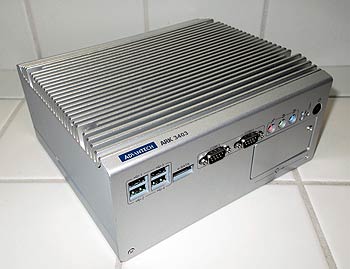 So how do industrial computer makers go about designing PCs suitable for those tasks? IPCs come in many different shapes and sizes, but the Advantech ARK-3403 generally represents what many IPCs look like these days: a compact steel box with cooling fins to eliminate the need for a fan, and with embedded systems circuitry inside.
So how do industrial computer makers go about designing PCs suitable for those tasks? IPCs come in many different shapes and sizes, but the Advantech ARK-3403 generally represents what many IPCs look like these days: a compact steel box with cooling fins to eliminate the need for a fan, and with embedded systems circuitry inside.
The ARK-3403 measures 8.7 x 7.9 x 4.1 inches and weighs about nine pounds, 3.5 of which are accounted for by the precision-machined aluminum top that serves as a massive heatsink. The housing itself is steel and aluminum and extremely rigid, several classes above what you get in a consumer tower PC. The board inside at first sight looks just like any other compact motherboard, but it's really more of a Single Board Computer built to exacting embedded systems standards. There's plenty of connectivity—some available via external ports directly mounted on the main board, some on peripheral boards, and some via numerous connectors and pins held in reserve for special requirements. What you also notice is the absence of the snake's nest of wires, daisy-chained connectors, and jumper cables you find in consumer desktops.
And there is no fan. It's not unusual for a consumer tower PC to have a massive CPU fan, an almost equally massive fan for the graphics card, and half a dozen fans around the housing. There's none of that in the ARK-3403. No fans means no electrical motors that can go bad, no noise, and no wires to connect all those fans. But it also means a need for meticulate thermal engineering so that the heat is spread and removed. This means that thermal engineering is an important part of the overall system design, and also that the design requires the large heatsink that dominates the look of many IPCs.
The image below shows the top view and all four side views of the ARK-3403. The housing is all-metal and feels exceedingly solid. Note the clean and purposeful design and execution that facilitates easy integration as well as easy expansion and painless maintenance.
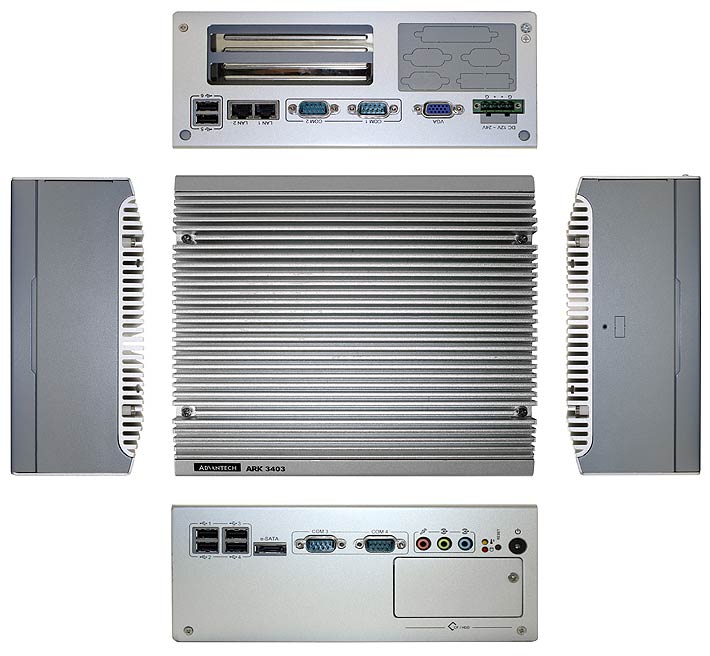
In terms of functionality and connectivity, this compact Advantech box PC can accommodate plenty of interface requirements. The ARK-3403 is configured to offer the following external and optional ports:
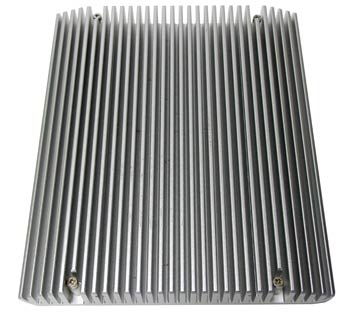
- 6 x USB 2.0 (4 front, 2 back, 2 additional optional ones inside)
- 1 x e-SATA
- 2 x Serial RS232
- 2 x Serial RS232/422/485 with auto flow control
- 2 additional optional RS232 inside
- Line-out, Mic-in, Line-in
- Optional 16-bit digital I/O
- 2 x RJ-45 gigabit LAN
- VGA video (handled WSXGA+ 1680 x 1050 in our lab)
- Power (12 to 24 Volt DC)
The ARK-3403 is designed to run off solid state storage medium via an externally accessible CompactFlash card slot. It also has internal drive bay space for two SATA 2.5" hard disks. The CF Card slot and the hard drive bays are located behind a hinged door below the power button and audio jacks. Our review unit ran Windows XP Embedded on a 4GB Advantech industrial grade SQFlash card and came with a 512MB Apacer PC2-5300 CL5 RAM module.
Below you can see what's inside the ARK-3403.
After removing the large finned heatsink that's held in place on top of the device with four Philips screws, you can see the heat spreader plate and heat transfer pipes that press against the main heatsink. Underneath the plate are the unit's Intel Atom D510 processor and ICH8-M chipset. Above the heat spreader plate is the board's sole SO-DIMM slot.
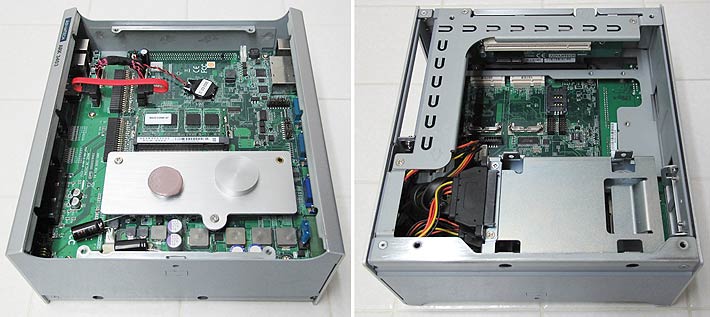
The above-right picture shows the ARM-3403 with the bottom plate removed. This provides insight into the ARK-3403's considerable, and very flexible, expansion capabilities. At the bottom is the hard disk subframe that can accommodate two 2.5-inch disks. It is shock-mounted onto the housing via rubber bumpers. Above that, on the main board, there are two unused mini-PCIe slots. To the right of that sits what looks like a SIM Card caddy. Above that is a daughterboard that can contain either two 5 Volt 32-bit half-length PCI slots (5 Volt keying), a PCI and a PCIe x1 slot, or two PCIe x1 slots.
In terms of ruggedness, the requirements for a boxed PC are different than those of a mobile computer. The housing is tough and very sturdy, and designed to handle the kind of shocks and vibration that may be encountered by fixed-mount system. Operating temperature is -4 to 131 degrees Fahrenheit for solid state storage equipped models—a wide enough range to use this industrial PC almost anywhere — and the computer fulfills a long list of EMC and safety requirements. Sealing against water isn't much of an issue for units mounted inside a vehicle, and so there isn't any watersealing at the ports. Vibration and shock, however, can be issues for IPCs, and so Advantec provides test data for IEC standards 60068-2-27 (shock) and 60068-2-64 (vibration).
Relative performance
Another interesting aspect of Advantech's IPCs is that they come with a wide range of performance. The ARK-3403 discussed here is equipped with a 1.66GHz Intel Atom D510 processor (and optionally with the 1.8GHz Atom D525). Intel introduced the D510 the end of 2009. It is a dual core processor specifically designed for use in low end desktops and similar devices. It has Intel Graphics Media Accelerator 3150-based integrated graphics, and compared to the original Atom N230/N330 that the D410 and D510 processors replaced, the chip count is down from three to two. The graphics core is running at a respectable 400MHz, compared to just 200MHz in the Atom N450 of the same Atom generation, the chip that powered many millions of netbooks.
Anyway, the D510 is a very economical processor that, combined with its companion ICH8M chip, has a thermal design power of no more than 15 watts. It provides the relative simplicity and low price of the Atom line with a nice performance advantage over "lesser" Atoms, and thus makes it interesting for applictions that require a bit more than just the basics. RuggedPCReview.com ran full performance benchmarks, and the below table shows those that relate to the processor itself (it'd make little sense to list all system benchmarks as graphics, disk, etc., depend on drivers and type of storage):
PERFORMANCE COMPARISON
CRYSTALMARK 2004R3
|
Atom D510
|
Core i7-620LE
|
Core 2 Duo T7400
|
Core Duo L2400
|
Atom N270
|
Atom Z530
|
|
Clock speed
|
1.66GHz
|
2.0GHz
|
2.16GHz
|
1.66GHz
|
1.6GHz
|
1.6GHz
|
|
Tested in Advantech:
|
ARK-3403
|
SOM-5788
|
PPC-157T
|
ARK-3399
|
SOM-5761
|
SOM-6760
|
|
Thermal Design Power:
|
13 watts
|
25 watts
|
34 watts
|
15 watts
|
2.5 watts
|
2 watts
|
|
ALU
|
11083
|
31419
|
19311
|
12971
|
5413
|
5376
|
|
FPU
|
9704
|
35007
|
22560
|
15353
|
4726
|
4667
|
|
MEM
|
6447
|
23251
|
10867
|
6407
|
4172
|
3667
|
What the benchmarks show is that processor performance of this Atom D510-based system is very clearly above that of Atom N270 and Z530-based boards or systems. It's also not far from that of lower end Core Duo systems, and even at about the 50% level of powerful Core 2 Duo setups. Higher speed Core i5 or i7 systems, however, are in a different class entirely, and the ARK-3403 is not designed to compete with them on performance.
Advantec describes the ARK-3403 as a "valuable performance solution with Intel Atom D510/D525, PCI/PCIe expansion and dual SATA HDDs for embedded controller applications." It is that, and more, and with a starting price of just US$900 it's also amazingly affordable for a high quality industrial PC.
-- Conrad H. Blickenstorfer
Advantech ARK-3403 Specs:
| Type |
Industrial Embedded Box IPC
|
| CPU Type |
1.66GHz Atom D510 (tested), or 1.8GHz Atom D525
|
| Chipset |
Intel ICH8-M
|
| BIOS |
AMI 16Mbit, SPI
|
| OS |
Windows XP Embedded (also supports Windows 7, XP Professional, Windows CE, Fedora 11)
|
| Memory |
Max 2GB DDR2 in 1 SDRAM 200-pin SODIMM socket (review system has a 512MB PC2-5300 CL5 Apacer RAM module) |
| Graphics Controller |
Intel GMA3150 |
| Watchdog Timer |
255-level timer intervals, software setup |
| LVDS |
Optional 18-bit LVDS |
| LAN |
2 x 10/100/1000 Mbps |
| Storage HD |
Supports drive bay space for two 2.5-inch SATA HDs
|
| Storage SSD |
Compact flash type I/II slot
|
| Expansion |
2 mini-PCIe, 1 PCI and 1 PCIe x1 (default) or 2 PCIe x1 (optional) or 2 PCI (optional); note: PCI slots for 5 Volt keying, 32-bit half-length cards
|
| Housing |
Aluminum housing for desk/wall mounting
|
| Vibration |
With CF disk: 5 Grms, IEC 60068-2-64, random, 5 ~ 500 Hz, 1 Oct./min, 1hr/axis. / MIL-STD 514.5C-3; With hard disk: 1 Grms, IEC 60068-2-64, random, 5 ~ 500 Hz, 1 Oct./min, 1hr/axis. / MIL-STD 514.5C-3
|
| Shock |
With CF disk: 50 Grms, IEC 60068-2-27, half sine, 11 ms duration; with hard disk disk: 20 Grms, IEC 60068-2-27, half sine, 11 ms duration. /MIL-STD 516.5
|
| EMC |
CE/FCC Class A, CCC, BSMI
|
| Safety |
UL, CCC, BSMI
|
| Operating temperature |
With CF disk: -4 to 131F (-20 ~ 55° C); with 2.5-inch extended temperature hard disk -20 to 45° C (with air flow)
|
| USB |
6 x USB 2.0 (plus 2 optional)
|
| Serial |
2 x RS232, 2 x RS232/422/485 |
| Parallel |
Optional D-sub 25-pin
|
| Audio |
Line-out, Mic-in, Line-in |
| Communication |
Optional via expansion slots (there is a SIM Card caddy)
|
| GPS |
Optional |
| DIO |
Optionally supports 16-bit Digital I/O |
| Size |
8.7" x 7.9" x 4.1"
|
| Weight |
8.8 lbs. |
| Power |
12 ~ 24VDC with AT/ATX power type; AC/DC adapter optional; typical power consumption 13 watts
|
| Price |
Starting at US$910 (see price configurations) |
| Datasheet |
Advantech ARK-3403 |
Advantech Corporation
38 Tesla, Suite 100
Irvine, CA 92618
Toll Free: 1-800-866-6008
Ph: 949-789-7178
Fax: 949-789-7179
ECGInfo@advantech.com
www.advantech.com
Advantech Co. Ltd.
No.1, Alley 20, Lane 26, Rueiguang Road
Neihu District, Taipei Taiwan 114, R.O.C.
Tel: 886-2-2792-7818
Fax: 886-2-2794-7301
www.advantech.com
|



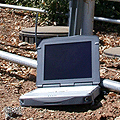

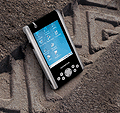
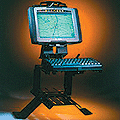





 So how do industrial computer makers go about designing PCs suitable for those tasks? IPCs come in many different shapes and sizes, but the Advantech ARK-3403 generally represents what many IPCs look like these days: a compact steel box with cooling fins to eliminate the need for a fan, and with embedded systems circuitry inside.
So how do industrial computer makers go about designing PCs suitable for those tasks? IPCs come in many different shapes and sizes, but the Advantech ARK-3403 generally represents what many IPCs look like these days: a compact steel box with cooling fins to eliminate the need for a fan, and with embedded systems circuitry inside.


